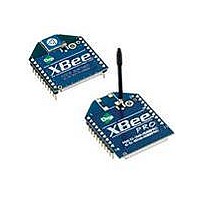XBP09-DPSIT-156 Digi International, XBP09-DPSIT-156 Datasheet - Page 34

XBP09-DPSIT-156
Manufacturer Part Number
XBP09-DPSIT-156
Description
MODULE XBEE PRO W/RPSMA
Manufacturer
Digi International
Series
XBEE-PRO™r
Specifications of XBP09-DPSIT-156
Frequency
902MHz ~ 928MHz
Data Rate - Maximum
156kbps
Modulation Or Protocol
FHSS
Applications
ISM
Power - Output
17dBm (50mW)
Sensitivity
-100dBm
Voltage - Supply
3 V ~ 3.6 V
Current - Receiving
80mA
Current - Transmitting
210mA
Data Interface
PCB, Through Hole
Antenna Connector
RP-SMA
Operating Temperature
-40°C ~ 85°C
Package / Case
Module
Lead Free Status / RoHS Status
Lead free / RoHS Compliant
Memory Size
-
Lead Free Status / Rohs Status
Lead free / RoHS Compliant
Other names
602-1169
XBee‐PRO® 900 RF Modules
Diagnostics
If a network has multiple subnets that have drifted out of phase with each other then follow the
following steps to get the subnets back in phase:
1. Place a sleep support node in range of both subnets.
2. Select a node in the subnet which you desire the other subnet to sync up with. Use this node to
slightly change the sleep cycle settings of the network (increment ST for example).
3. Wait for the subnet's next wake cycle. During this cycle the node selected to change the sleep
cycle parameters will send the new settings to the entire subnet it is in range of, including the
sleep support node which is in range of the other subnet.
4. Wait for the out of sync subnet to wake up and send a sync. When the sleep support node
receives this sync it will reject it and send a sync to the subnet with the new sleep settings.
5. The subnets will now be in sync. The sleep support node can be removed. If desired the sleep
cycle settings can be changed back to what they were.
In the case where only a few nodes need to be replaced this method can also be used:
1. Reset the out of sync node and set its sleep mode to cyclic sleep (SM=8). Set it up to have a
short sleep cycle.
2. Place the node in range of a sleep support node or wake a sleeping node with the
commissioning button.
3. The out of sync node will receive a sync from the node which is synchronized to the network
and sync to the network sleep settings.
The following are useful in some applications when managing a sleeping router network:
Query current sleep cycle: The OS and OW command can be used to query the current
operational sleep and wake time a module is currently using.
Sleep Status: The SS command can be used to query useful information regarding the sleep
status of the module. This command can be used to query if the node is currently acting as a
network sleep coordinator as well as other useful diagnostics.
Missed Sync Messages Command: The MS command can be used to query the number of
cycles that have elapsed since the module last received a sync message.
Sleep Status API messages: When enabled with the SO command, a module configured in API
mode will output modem status frames immediately after a module wakes up and just prior to a
module going to sleep.
© 2009 Digi International, Inc.
• If multiple modules in the network have had the non-sleep coordinator sleep option bit dis-
• If the modules in the network are not using the auto early wakeup sleep option.
abled and are thus eligible to be nominated as a sleep coordinator.
34














